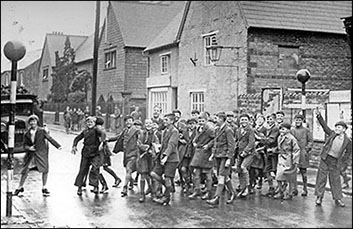Julius Caesar, Shakespeare's Globe, Bankside
When I first heard, some years ago, that "they" we're going to rebuild a theatre like Shakespeare used to work in, roughly on the same site, I was incredibly excited by the imagination and vision of such a project. One of my early cinema-going memories was, with my parents, seeing the Olivier Henry V. There is much to savour about this film, and my 14-year-old self was very taken with the clever breakout to, and return from naturalism, that the film employs. It starts and ends with a performance in a Shakespearean theatre. But in between, they film in the real out-of-doors - your actual vasty fields of France - that Prologue works so hard to sketch before us - we gentles all:
"And let us, ciphers to this great accompt,
On your imaginary forces work".
I was captured by the bold, preposterous, imaginative leap that Shakespeare asks his audience to take, to fill the stage with imagined castles, armies, steeds, Kings:
"Suppose within the girdle of these walls
Are now confined two mighty monarchies,
Whose high upreared and abutting fronts
The perilous narrow ocean parts asunder:
Piece out our imperfections with your thoughts;
Into a thousand parts divide one man,
And make imaginary puissance;
Think when we talk of horses, that you see them
Printing their proud hoofs i' the receiving earth;
For 'tis your thoughts that now must deck our kings,
Carry them here and there; jumping o'er times,
Turning the accomplishm
ent of many years
Into an hour-glass".
So, I was captivated - utterly subscribed - to the idea of a theatrical world of the imagination, where the text cleverly sets the scene and we, the gentle audience, go with it. As school went on I became increasingly captured by the wonder and art of Shakespeare, and theatre in general. I had a modest understanding of Shakespearean performance practice - not through formal study, but just from watching plays.
And so, the notion of a theatre doing plays more or less in the way Shakespeare saw them played, captivated me. I never thought I'd actually get to attend the Globe. I was just happy in the knowledge that such a place existed.

But, yesterday, all that changed. We went to Shakespeare's Globe. And saw Julius Ceasar. This is a play that has been a favourite of mine since 4th form high school. I was incredibly lucky to have a couple of English teachers who instilled in me a great love of reading. One was Mr Cloran, who talked with great love and insight about Julius Caesar, and made the text come to life. So, when we were planning a trip to London, Shakespeare's Globe was at the top of the hit list. Number one, with a bullet. And we determined immediately to get the whole, "authentic" experience, by going as groundlings - the punters who stand at ground level to view the play. The plebeian crowd who came for Shakespeare's low comedy, rude mechanicals, and the violent downfall of their betters; who'd definitely like a slice of Schadenfreude with that. So, we were aware that groundling tix meant a few hours of standing still, in a crowd. But, for only five quid it was a badge of honour we were ready for. (Later, in the shop, we see a T-shirt that says "Groundlings - proudly standing since 1599". We grab one.)
The production makes great use of the possibilities afforded by the geography of a Shakespearean theatre. The play starts with a rabble moving through the groundling pit, leading an audience chant in support of the upstart Julius Caesar. The play repeatedly enlists us groundlings as the mob; most notably in Mark Anthony's funeral oration, where Shakespeare cleverly turns the tables on the conspirators and demonstrates the fickleness and malleability of the mob. The production also benefitted from a great use of music, and costume design that was largely Elizabethan, with only touches of "Roman" in places. Acting was generally fine - in particular Christoper Logan's fey, gay Casca gave strong point to the ignobility of the conspirators' cause. I also liked the twist of using Julius Caesar in the role of Strato, who assists Brutus' suicide. Thus us Caesar's revenge on the conspirators complete.

We were totally engaged by this performance. Being in this setting is part of the total theatrical experience, and I loved it. Is it "authentic"? Well, I'm not a Shakespeare scholar, and no doubt they've worried that question to death. Certainly it was dynamic, moving, committed, and very believable. I can't wait to see Henry V in this theatre ...
The other thing I really enjoyed about this was seeing Shakespeare, in this theatre,mosur founded by English men and women. This is their living heritage, and I found it very encouraging to see them enjoying it with rapt attention. A bunch of young teens ran the gamut from close attention to total boredom. I loved that.
The play's not over until the blood's mopped up.
* * * *
Coda: On the way home we ran into a big demo. Kurds protesting against IS had occupied a major intersection in northeast London - traffic was log jammed and buses were stopped. We had to walk through the noisy demo to get home. Having just seen the volatility of a mob made clear on stage, it caused a moment's hesitation. We survived.



























